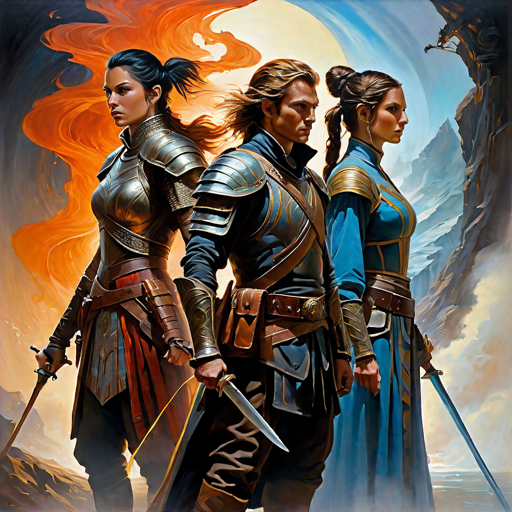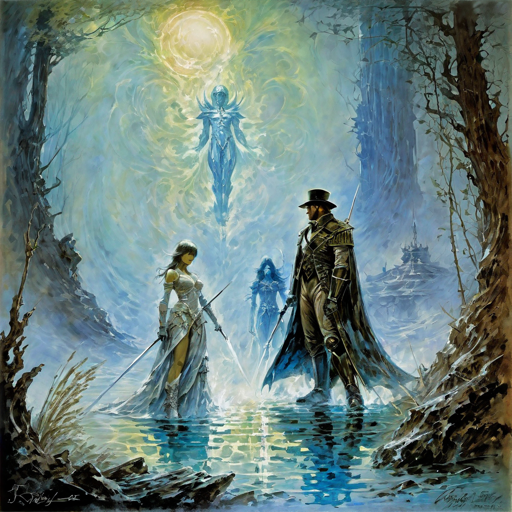How to Effectively Write Multiple Protagonists into One Narrative
Fantasy epics stand as bastions of grandeur and complexity, challenging authors to navigate the intricate dance of multiple characters and their intertwining storylines.
From Tolkien's Middle-earth to Martin's Westeros, these narratives embody the rugged essence of the genre. In this discourse, we delve into the nuanced strategies necessary to command this literary tapestry, ensuring a seamless fusion of characters and narratives in the realm of fantasy.
Establishing a Strong Core Narrative
At the core of every fantasy epic lies a narrative bedrock, a conceptual anchor that guides the tumultuous seas of plot and character.
Whether it be the pursuit of power, the clash of titans, or the journey of self-discovery, this foundational narrative instills purpose and direction. Before embarking on the labyrinthine journey of character and plot, one must first chart the course of this overarching narrative, discerning how each character's path intertwines with the grand tapestry of the tale.
In crafting a compelling core narrative, it's imperative to imbue it with the weight and gravitas befitting an epic. Themes of honour, sacrifice, and destiny resonate deeply within the hearts of readers, anchoring them to the story's emotional core. Consider the timeless struggles of heroes and villains alike, drawing inspiration from myths and legends that have stood the test of time.
By establishing a robust narrative foundation, writers lay the groundwork for the epic journey that lies ahead, guiding characters through trials and tribulations toward their ultimate destinies.
Developing Well-Rounded Characters
Characters in a fantasy epic are not mere pawns but rugged individuals, each with their own grit and resolve.
Motivations, desires, and vulnerabilities make them not only players in the narrative but agents of change in their own right. It falls upon the author to delve deep into their characters' souls, revealing layers of complexity that breathe life into the tale.
To create characters that resonate with readers, delve into the depths of their psyche, exploring their fears, desires, and inner conflicts. Consider their upbringing, experiences, and traumas, shaping them into multidimensional beings with strengths and flaws alike. Allow them to evolve and grow over the course of the narrative, confronting their demons and forging their own paths amidst the chaos of the fantasy world.
By breathing life into these characters, authors ensure that their journeys resonate with authenticity and emotional resonance.
Utilising Multiple Points of View
The fabric of a fantasy epic is woven from myriad threads, each representing a distinct perspective on the unfolding saga.
Employing multiple points of view allows the author to cast a broad gaze upon the world they have created, enriching the reader's understanding of its complexities. Yet, such narrative diversity must be wielded with a firm hand, ensuring harmony amidst the cacophony of voices.
In embracing multiple points of view, authors unlock a wealth of narrative potential, providing readers with insights into diverse cultures, ideologies, and experiences within the fantasy realm. However, it's essential to maintain clarity and coherence amidst the shifting perspectives, guiding readers through the labyrinth of the narrative with skill and precision.
By weaving these disparate threads together into a cohesive tapestry, authors create a rich and immersive world that captivates the imagination and leaves readers yearning for more.
Creating Interconnected Plotlines
Chance encounters, shared goals, and conflicting ambitions bind characters' destinies together, fortifying the story's structural integrity. These connections imbue the tale with an organic unity, wherein each subplot resonates with the heartbeat of the whole.
Maintaining Narrative Momentum
It is easy to lose oneself in the labyrinth of subplots and secondary characters. To keep the fires burning and the pace brisk, the author must navigate the currents of the tale with unyielding resolve. Each chapter should drive the story forward with the force of a charging army, propelling the narrative toward its climactic crescendo.
Knowing When to Consolidate
There exists a finite capacity for narrative complexity, recognising when to prune the narrative thicket and consolidate disparate elements is a skill akin to that of a seasoned commander leading his troops into battle. Focus on the core characters and plotlines that form the backbone of the tale, trimming away excess to reveal the story's true essence.
In the crucible of fantasy, where worlds are forged and destinies entwined, the art of balancing multiple characters and storylines is both a test of strength and a testament to prowess. By anchoring the narrative in a sturdy core, infusing characters with depth and resolve, embracing narrative diversity, fostering interconnected plot lines, maintaining unrelenting momentum, and judiciously consolidating elements, the author can craft a tapestry of unparalleled masculinity and might.
Come, together let us embark upon this epic odyssey, where characters and storylines converge and diverge like titans on the battlefield, and may the resulting narrative thunder with the power of a thousand war drums.
Pros & Cons of Using Multiple Protagonists
Pros
Diverse Perspectives:
Multiple protagonists offer readers a multifaceted view of the story's world, events, and conflicts. Each protagonist brings their unique background, motivations, and experiences to the narrative, enriching the storytelling and providing readers with a deeper understanding of the story's themes and dynamics.
Rich Character Development:
With multiple protagonists, writers have the opportunity to delve deeply into the inner workings of each character, allowing for nuanced and comprehensive character development. Readers can witness the growth, struggles, and triumphs of each protagonist, forging emotional connections that drive the narrative forward.
Increased Narrative Complexity:
Multiple protagonists can add layers of complexity to the story, weaving together disparate plot lines and subplots into a cohesive whole. This complexity can intrigue readers, keeping them engaged as they unravel the intricacies of the narrative and uncover the connections between characters and events.
Cons:
Potential for Confusion:
Managing multiple protagonists can be challenging, especially for readers who may struggle to keep track of numerous characters and storylines. Without clear delineation and effective storytelling techniques, the narrative can become convoluted, leading to confusion and frustration among readers.
Counter this by keeping a journal where you have clearly outlined each characters storyline.
Balancing Character Screen Time:
With multiple protagonists vying for attention, writers must carefully balance the allocation of "screen time" to each character. Neglecting certain protagonists or giving disproportionate focus to others can result in uneven pacing and dissatisfaction among readers who may feel disconnected from certain characters or storylines.
Risk of Diluted Focus:
Introducing multiple protagonists runs the risk of diluting the focus of the narrative, diverting attention away from the central conflict or theme. Without a strong central thread to anchor the story, the narrative may meander aimlessly, lacking the cohesive structure and emotional resonance necessary to captivate readers.
Overall, while using multiple protagonists can enrich the storytelling experience by offering diverse perspectives and complex character dynamics, it also presents challenges in terms of narrative clarity, character development, and maintaining focus. Writers must carefully weigh the pros and cons, employing effective storytelling techniques to harness the full potential of multiple protagonists while mitigating potential pitfalls.
Pro Tips for Authors Writing Multiple Protagonists
1. Establish Clear Character Arcs and Goals:
- Clearly define each protagonist's individual arc, motivations, and goals from the outset.
- Ensure that each character's journey is distinct and contributes meaningfully to the overall narrative.
- Develop character-specific conflicts and obstacles that drive their growth and development throughout the story.
2. Use Distinctive Voices and Perspectives:
- Differentiate each protagonist through their unique voice, perspective, and narrative style.
- Utilise different points of view (first-person, third-person limited, etc.) to provide readers with varied insights into each character's thoughts and experiences.
(NB: Be careful using multiple points of view, this has great potential to confuse the reader further unless done well.)
- Incorporate cultural backgrounds, speech patterns, and personal quirks to make each protagonist memorable and authentic.
3. Interweave Plotlines Seamlessly:
- Integrate multiple protagonists' storylines in a cohesive manner, ensuring that they intersect and influence one another organically.
- Create moments of convergence and divergence where characters' paths intersect, driving the narrative forward and deepening the connections between them.
- Employ foreshadowing and callbacks to hint at future interactions and plot developments, enhancing the sense of narrative cohesion.
(NB: when plot lines connect be sure to carefully select which character’s point of view is taken for the inital interaction.)
4. Maintain Balance and Focus:
- Strive to balance the prominence of each protagonist, giving them equal weight and attention within the narrative.
- Use chapter breaks or alternating viewpoints to manage transitions between characters and prevent reader fatigue.
- Keep the central conflict or theme of the story front and centre, ensuring that each protagonist's storyline contributes to its resolution.
5. Foster Character Interaction and Growth:
- Capitalise on opportunities for protagonists to interact and influence one another, fostering dynamic relationships and character dynamics.
- Create conflicts and alliances between protagonists that challenge their beliefs, values, and loyalties, driving character development and plot progression.
- Allow characters to learn from one another and evolve through their interactions, deepening their bonds and adding layers of complexity to the story.
By implementing these pro tips and tricks, you can effectively navigate the complexities of multiple protagonists, crafting compelling narratives that resonate with readers and leave a lasting impact.
Writing multiple protagonists is difficult and is potentially disastrous if done poorly. I had to rewrite the first book of Chaos of Choice because it did not work. After reassessing the narrative and characters I made careful note of the above tips to plan an engaging and effective narrative with multiple protagonists.
So, it can be done, and done well (just look at LoTR, GoT, & the Marvel Series), it just takes a lot of effort and carefully structuring your story. GL
Til next time.
If you want to learn more about building a believable and immersive fantasy world and improving your writing, check out my other posts:
PS - Don’t forget to sign up below for updates on new book releases and blog articles. Also, drop by my Patreon and socials.




